For various reasons I’ve been off work for a while and that has meant being off blogging as well. If you’ve commented on posts recently then thanks; if you’ve emailed my gmail account and still would like a reply then maybe try again.
Anyway, what better way to resume making the occasional post here than a film about the place where I did some of my first ever fieldwork: assessing the then-proposed Site Z dam site on the Stikine River in Tahltan territory, far Northwestern British Columbia, in the shadow of Mt. Edziza. Edziza is well known to Northwest Archaeologists as one of the region’s most important sources of obsidian, a volcanic glass highly suitable for making certain kinds of stone tools.
The video, Edziza: Life from Ash and Ice, can be watched in full on the B.C. Knowledge Network’s web site. (NB: I had to change the resolution from a default of “lousy”). Obviously the geology of the Edziza Complex is pretty cool (and is covered in the first half of the video, which features John Clague among others), but there’s quite a bit of more direct archaeological interest in the second half.
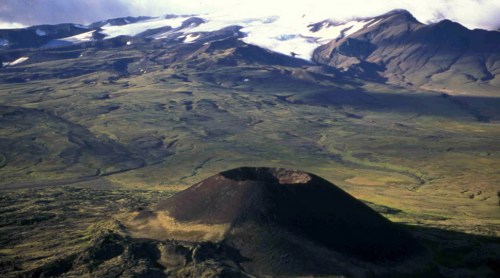
Cinder cone near Mt. Edziza. Mad Dog had the idea of landing the helicopter on top of this, which was not a good idea. Source: BC Film Commission.
The main archaeological interest starts at about 30:45 of the film, with a great sequence showing a mountainside interview with the Tahltan Nation’s Hotseta Oscar Dennis, who explains the origin of the name Edziza (pronounced by him something like E-dees-DAH) and some of the ritual knowledge necessary to approach and ascend the mountain for the purposes of obsidian gathering. He then demonstrates his obsidian flaking techniques, noting the connection he feels when he realizes his own debitage will be left there for another 10,000 years or more.
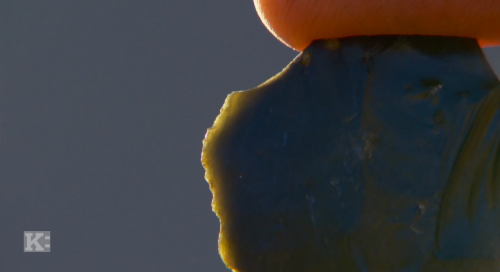
Freshly made flake of Edziza obsidian held by Hotseta Oscar Dennis. Source: Knowledge Network screen grab.
Around 36:30 there is a segment interviewing Wade Davis (now at UBC), then at about 39:45 we have another archaeological segment featuring Dr. Rudy Reimer / Yumks of SFU, who discusses the use of X-Ray Fluorescence analysis to determine the sources and distributions of obsidian in the archaeological record. By being able to say that an artifact found in, say, the Salish Sea, is made of Obsidian from Edziza then we can say that either that artifact, or the raw material, was moved by people the length of the Province. Accumulating multiple such sourced artifacts can give great insight into social networks of the past. Anyway, Rudy does a great job of explaining XRF, while communing with a lump of obsidian the size of a small asteroid. There’s a nice cameo from SFU archaeology student Jordan Handley as well. Of course, Reimer and Handley are following the lead of Dr. Knut Fladmark, whose 1985 book Glass and Ice brought the mountain into the heart of the BC Archaeological imagination. If you have institutional access, you’ll probably be interested in this 2015 article by Rudy which encapsulates and advances our current knowledge of archaeological uses of Mt. Edziza obsidian. Reimer, Rudy, Reassessing the role of Mount Edziza obsidian in northwestern North America, Journal of Archaeological Science: Reports, Volume 2, June 2015, Pages 418–26, doi:10.1016/j.jasrep.2015.04.003 (currently this article is open-access but that could change I suppose.)
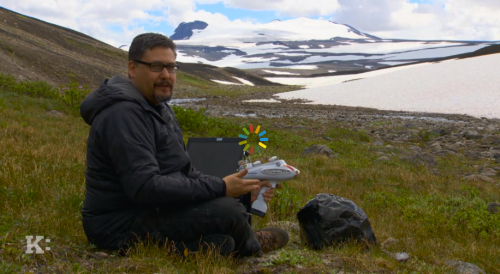
Dr Rudy Reimer / Yumks with a portable XRF (set to stun) near an obsidian boulder on the flanks of Mt. Edziza. Source: Knowledge Network screen grab.
If you watched the Wade Davis segment, you might have noted it as a bit of a love-letter to obsidian. Who doesn’t love things that glint? And certainly it’s an exotic and very useful raw material that is also amenable to certain archaeological analyses. People seem to have sought it out early – apparently it made it to islands in the Alaska Panhandle at the PET-408 (On-Your-Knees Cave) site by around 10,000 years ago, and I’ve heard Millennia Research has possible Clovis-era bifacial preforms made from it in the Williston Lakes reservoir/upper Peace River area.. I sometimes think we fetishize obsidian a little though. It’s not the be-all to end-all for all stone tool manufacture: it might be too brittle, or too rare, or come in too-small pieces, for many tasks. Other toolstones, like rhyolites and fine-grained volcanics, may have equally interesting stories to tell – and don’t even get me started on ground stone technology. Not to take the shine off obsidian of course, but it might be a good time to extend those few studies which have looked at the geochemistry and distribution of other materials as well.
Anyway, this is a good video that takes a holistic look at Mt. Edziza. It contains a lot of wonderful scenery of the area as well as of the actual quarry sites on the flanks of the mountain. If you’re a teacher of NW Archaeology then the latter section of the movie might well be useful to show in class. Another couple of interesting links might be this well-written short article featuring UVIC’s own Dr. Darcy Mathews; this short, impressive video of some higher elevations on Edziza, and this trailer for what seems to be an interesting film recently completed about the mountain.
A final note: since this blog has been dormant it could be we’re down to the core 11 readers again. If you’d care to share it on social media that would help with getting the word out there’s going to be occasional posts again going forward – thanks.

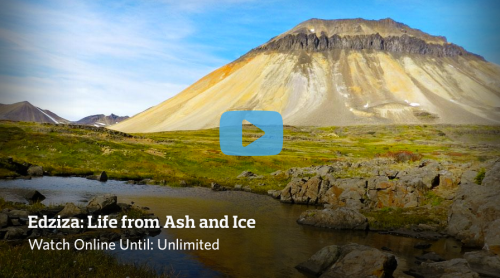
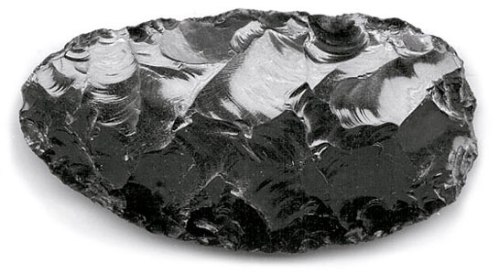
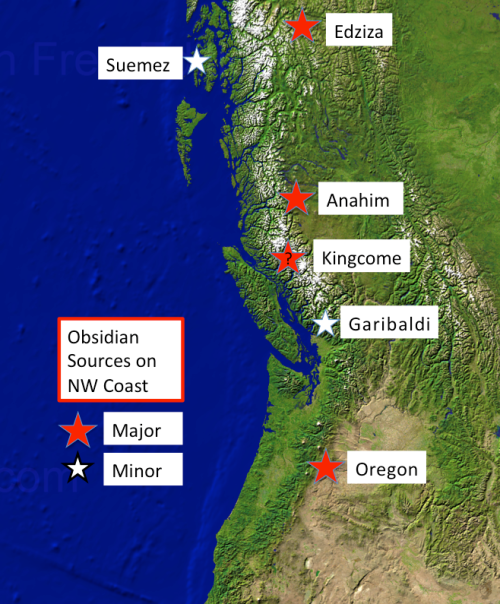

Quentin,
Great to get you Mt Edziza post!
Thanks,
Dan
Daniel Stueber 15119 SE River Rd. Portland, OR. 97267 503-652-xxxx Hm 503-708-xxxx Cell http://www.thunderstones.com
>
LikeLike
Thanks for posting this! It was amazing to have the chance to work up there and zap things with my XRF! Cheers!
LikeLike
I always look forward to seeing updates from your blog in my email inbox.
LikeLike
it can be watched anytime online:
https://www.knowledge.ca/program/edziza-life-ash-and-ice
>
LikeLike
Nice post– can’t wait to sit down with the laptop at home to watch the video. And, glad you’re back, Quentin!
LikeLike
Hi all, good to hear from some of the regulars 🙂
Dan, I edited out your phone numbers on the chance you didn’t want them to go on the web.
Rudy, looking forward to more from you on Edziza. I’ve heard that Obsidian Cove obsidian (Suemez) may be indistinguishable from Edziza but not sure I’ve seen that in print yet.
LikeLike
Yeah I’ve talked with Madonna Moss about this, and the JASR article is to present one side of the data in regards to this. I am waiting for their work with much interest!
LikeLike
Great to read your voice again, Q. Still wish we’d landed in the crater, that little Hughes 500D would have fit no prob. Looking forward to viewing the video.
LikeLike
I wish I could see it. I’m in the UK. It’s only available in Canada😔
LikeLike
Hi Quentin, great post!
I hope to clarify and communicate a few things regarding Edziza obsidian in the Williston Reservoir area, specifically, the Finlay Reach (once the lower Finlay River valley). This area is about 500 km east of Edziza, on the western slopes of the Rocky Mountains in the Rocky Mountain Trench.
Obsidian is quite common and makes up about 10% of all lithic material recorded in the Finlay. For numbers, the total weight of obsidian from the largest collected archaeological assemblage (representing the minimum amount people transported and left in the Finlay) is about 6 kg from ~675 artifacts. We tracked down all of the XRF sourcing reports we could find for the Finlay (28 samples total; thank you, NROSL and Rudy!) and more than two thirds of the results suggest Edziza, the vast majority of these indicating the Flow 3/ Goat Mountain quarry area.
In terms of age, there is a cache of three large, polyhedral macroblade cores, which, while the technology is identical to Clovis blade cores (think Texas), we interpret them as somewhat more recent for a few reasons I won’t get into. The oldest cross dated obsidian artifact is an Alberta point base, so still very early (about 11,000 cal BP), but this artifact was not analysed with XRF so we are currently unsure if Edziza (it is probably Edziza). There are relatively few diagnostic late artifacts.
One cache of obsidian, which appears to be all Flow 3, was comprised of a number of unmodified flake blanks and four small, standardized, ovoid bifaces that were probably projectile point preforms. Interestingly, these appear to have been made from large flake blanks on the journey from Edziza, and show much less overall wear (related to travel) than the flake blanks in the cache. I think this cache is interesting as it is probably quite representative of the type of ‘package’ people were carrying/trading for hundreds of kilometers.
Cheers,
Roger Eldridge
Millennia Research
LikeLike
Cool stuff! and thanks for the info about the Williston materials. If you got any others you want looked at, you know how to find me!
LikeLike
rad your back on blog!
LikeLike
Mad Dog — uh, we’d still be digging that chopper out if we had landed. Of course, that was back in the day when a lot of the pilots were Vietnam vets and they had, shall we say, a differently calibrated danger-meter. (So we’d be digging with very large knives.)
Roger – thanks for that info. Such a cool assemblage from Williston Lake, and big chunks of Mt. Edziza are making it there from what I’ve seen and what you say. So an Alberta Point made on Edziza obsidian? That “Plains” thing is creeping westward (cf. Duncan’s Scotsbluff Pt at Stave watershed near Vancouver).
Carolyn – sorry about the video availability. Come back soon, or try Hola.com potentially?
Iain – or is that “UVIC’s own Iain?” – glad to be back now the pointy heads have let me. I’ll try to fit in some fishguts for you.
LikeLike
“back in the day when a lot of the pilots were Vietnam vets”– those guys used to scare the be-jeebies out of me, because they’d take you pretty much anywhere you asked them to, even if you were a newbie archaeologist who had no real understanding of what helicopters could– or could not– do!
LikeLike
Pingback: Northwest Coast Archaeology is back! | Mirabilis.ca
Great to see another post — and the subject matter. And speaking of far-flung trade sources: I believe Smith Cove here on the Sunshine Coast just yielded up some tool debitage from North Dakota. It appears to be heavily patinated Knife River flint. Not the first example here in coastal BC, apparently, That’s a distance of over 2,000 kms. It would be useful to have Rudy’s XRF scan of this….
LikeLike
I can always give that a try! Send it to me here at SFU and I will see what I get and I can send the piece back to you.
LikeLike
Here’s a recent UA thesis on identifying Knife River Flint:
http://hdl.handle.net/10048/1743
LikeLike
Many thanks, Quentin. You know, I wonder if it’s feasible to crowd-source a database so all of these artifact-related Northwest items could be known. It would be an amazing resource with innumerable uses: establishing exchange routes, comparative typologies and so on. I’d certainly be willing to contribute a few dollars towards the effort.
LikeLike
Thanks for the offer, Rudy; can you shoot me your current e-mail so we can arrange this, please? My attempts to the one I had don’t seem to have gotten through. My current one: rmikesteele@gmail.com
LikeLike
Hi Mike. Do you mean a database of artifact raw material sourcing? There’s been a start on the obsidian sourcing catalogue through several published glass libraries, and there is a recent PhD from UBC (J. Morin) that looks at Nephrite and ground stone tool materials as well. But that may not be what you mean.
In case he doesn’t reply, try rudyr [at] sfu dot ca.
LikeLike
Thanks, Quentin. Where the database is concerned I’m thinking of some way to create an online resource for projectile points (and wouldn’t rule out tool debitage as a secondary concern) as much as anything. It’s easier to get a handle on distribution patterns/typological associations in the US than here. And since we’re on the topic — I’d love to see something that encompassed ALL of the Pacific Northwest, American and Canadian.
LikeLike
Scott – yeah, some of them were quirky, you could say.
Mike – thanks for the comment. I think I may owe you an email from way back about this. If it (KRF) can be sourced using XRF then I’m sure Rudy would be interested. Visual appearances can be deceiving but I’ve heard that KRF is extremely distinctive, and it would be very unusual to find any out here on the coast, for sure.
LikeLike
Hi Q,
This answers Carolyn’s complaint. My friend Jim Baichtal in Thorne Bay Alaska asked me how to get this video, after reading about it here. He couldn’t view it either.
I just received this response from Knowledge Network to my inquiry:
“Edziza: Life from Ash and Ice” is available to purchase through the distributor. Here’s how to reach them:
Out Yonder Productions
25592 Telkwa High Road
Smithers, BC V0J 2N7
Phone: 250-847-5605
http://www.outyonderfilms.com/
Specifically here: http://www.outyonderfilms.com/dvds/life-from-ash-and-ice/
They have it listed for $20.00 plus tax and shipping.
All the best,
Susan Crockford
LikeLike
Mike- That would be amazing if Knife River Flint had made it all the way to the coast. We are currently looking at a possible KRF wedge shaped microblade core (and some other potential KRF) from the Williston Reservoir, and are also trying to establish if these are KRF or some correlate from an unknown source. There are a few things to look for microscopically apparently; Bob Dawe at the Royal Alberta Museum is very knowledgeable about this material, hopefully he will not mind me passing his name on here…
LikeLike
Susan, Hi, and thanks for that info. I linked earlier to Hola.org as a workaround to view the film but of course it would be best to support the Knowledge Network financially too! See you on campus soon, it seems.
Roger – keep us posted or do a guest post here on the KRF from Williston if it turns out to be legit!
LikeLike
what a treat to hear from you again! All the best from Haida Gwaii.
Maggie Stronge
LikeLike
Hi Q! Lurking here as always.
Pete
LikeLike
Q – Glad to see you back in blog world – a welcome break from the interminable humdrum! Keep it coming.
A
LikeLike